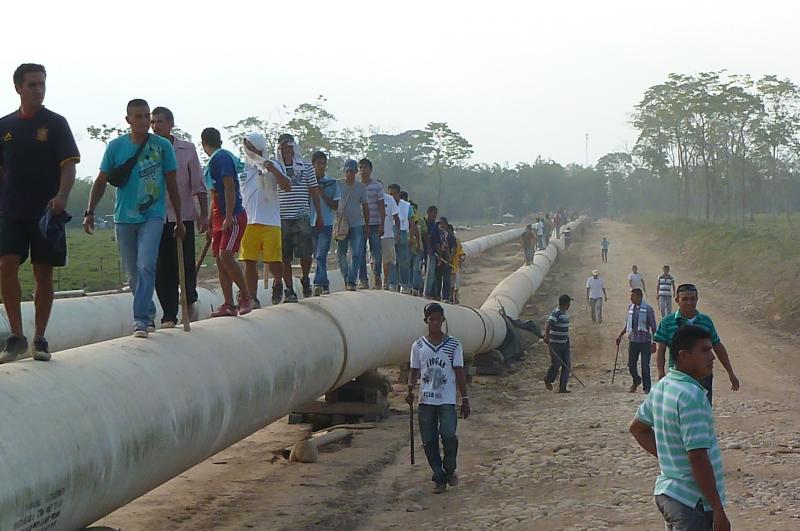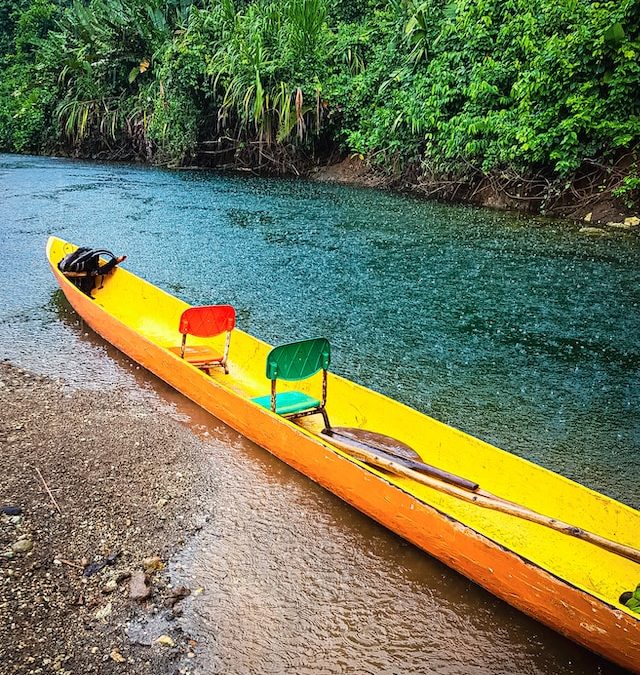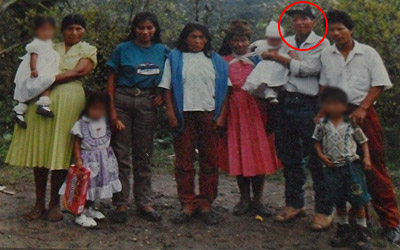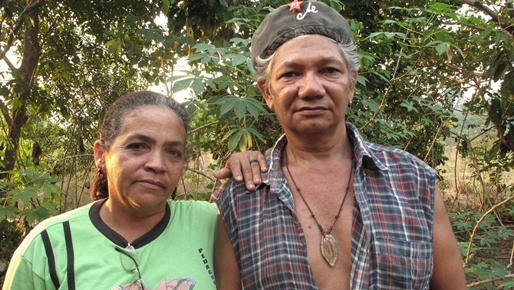
by Deep Green Resistance News Service | Feb 25, 2013 | Indigenous Autonomy, Noncooperation, Protests & Symbolic Acts, Repression at Home
By Colombia Informa; translation by Molly Fohn
After two weeks of peaceful protesting against oil exploitation in Arauca, on February 12 that department’s social organizations began a strike announced a few days earlier as a response to the repeated broken promises by the national government and transnational companies.
The last attempt at dialogue took place on Monday, February 11, between the Commission’s spokespeople (composed of a delegation of indigenous people, peasants, youth, women, workers and community members) and representatives of the Minister of the Interior, as well as oil companies that operate in the region, with the goal of establishing the conditions that would allow the fulfillment of those promises that they’ve been making since May 2012.
The repeated lack of follow-through by the government and businesses, and the delay in the negotiation process caused the fracture in the space for dialogue, followed by the use of state force: approximately 1,200 members of the Mobile Anti-Disturbance Squadron (the ESMAD in Spanish) arrived to violently evict the communities at the protest sites.
The first act occurred on the walkway San Isidro, over the de Tame road toward the Arauca capital, at the gate to the petroleum complex Caricare, which is used by the transnational company OXY, where ESMAD, the Police, and the Army assaulted the mobilized communities by setting fires to the surrounding pastures, discharging their weapons, destroying common buildings (a school), taking away the food supplies to the protestors, and beating and retaining four people.
As a result of the violence, a pregnant indigenous woman who was passing through lost her baby because of the effects of the tear gas, and had to receive emergency attention at a medical center.
The police had kept local and national reporters from contacting CM&, RCN, and other local media that moved to Caricare; the national army set up a checkpoint in the sector of Lipa that prohibited the passage of reporters “for security reasons.” It should be noted that in the Quimbo (Huila) events the police also restricted the presence of the media and acted out a series of violations of basic human rights and International Humanitarian Rights (DIH).
In the face of the this situation, the Human Rights Foundation Joel Sierra posted an Urgent Action which stated its concern for the detention of people, aggression and brutal violence exercised against the peasants and indigenous peoples, the infractions of the International Humanitarian Rights committed by the police to violate and destroy civil installations, and the removal of supplies for feeding those protesting. The Foundation also insisted that the Colombian State respect human rights and the International Humanitarian Rights norms.
In similar form, Urgent Action denounced a series of violations to the protestors’ rights by the police, whose members have dedicated themselves to constantly photograph those that participate in the protests, have retained, interrogated, and reported some of them, and have appeared in civilian clothing and armed in the middle of the night at the edges of the protest sites, among other cases.
In the rest of the protest sites, like the gate to the petroleum complex of Caño Limón in the municipality of Arauca, the town of Caricare in Arauquita, the bicentennial pipeline in Tamacay and el Tigre (Tame) and in Villamaga (Saravena) and the fire substation of Banadías (Saravena), the authorities have sent contingents from the army, the national police, and the ESMAD, because they fear the same will happen in those places that happened in Caricare.
It’s important to note that at this time people and vehicles cannot travel by land to get outside of the department of Arauca by the only two major roads (Casanare and Norte de Santander), and all commerce and activity is completely paralyzed in that region of the country.
From Upside Down World: http://upsidedownworld.org/main/news-briefs-archives-68/4140-colombia-riot-police-attack-communities-protesting-oil-exploitation-in-arauca-
by Deep Green Resistance News Service | Dec 15, 2012 | Repression at Home
By Amnesty International
Human rights defenders across the Americas are facing escalating levels of intimidation, harassment and attacks at the hands of state security forces, paramilitary groups and organized crime, Amnesty International said in a new report today.
The report Transforming pain into hope: Human rights defenders in the Americas, is based on around 300 cases of intimidation, harassment, attacks and killings of human rights defenders in more than a dozen countries primarily between January 2010 and September 2012.
“Human rights defenders are systematically harassed, attacked and subjected to unfounded criminal charges in almost every country in the Americas to prevent them from speaking out for the rights of the most marginalized,” said Nancy Tapias-Torrado, Americas Researcher on the Situation of Human Rights Defenders at Amnesty International.
Throughout the Americas, human rights defenders have been publicly condemned as “illegal”, “illegitimate”, “unscrupulous” or even “immoral”. They have been accused of being criminals, corrupt, liars, troublemakers or subversives; of defending criminals; and of supporting guerrilla groups. Such public criticisms have been voiced by government officials as well as non-state actors.
“Men and women who work to protect human rights are also targeted as they are seen by powerful political and economic interests as an obstacle to major development projects,” said Tapias-Torrado.
Those particularly targeted include people working on issues related to land and natural resources; the rights of women, lesbian, gay, bisexual, transgender and intersex people, abuses against migrants as well as those working to ensure justice for human rights abuses, plus journalists, bloggers and trade unionists.
Of the almost 300 cases analyzed by Amnesty International, those directly responsible were convicted in only four cases.
Almost half of the cases documented by Amnesty International took place in the context of disputes over land, in countries including Brazil, Colombia and Honduras. Several were related to large-scale development projects led by private companies.
In countries including Cuba and Mexico, human rights defenders have suffered judicial harassment, have been detained on the basis of flawed evidence or have had spurious charges hanging over them for years because arrest warrants are issued then not acted on.
Indigenous human rights defenders José Ramón Aniceto Gómez and Pascual Agustín Cruz, from Puebla, Mexico, were released from prison on 28 November 2012, after the country’s Supreme Court of Justice overturned their unfair conviction.
They were sentenced, in 12 July 2010, to seven years in prison, accused of stealing a car.
The case was brought by a member of a powerful local cacique group that had for many years restricted access to water and charged connection fees that represented four monthly wages for many community members. The two defenders had fought to establish free mains water connections to people’s houses.
The Court’s decision on this case confirms Amnesty International’s conclusion that the case against these defenders was a total injustice.
In several countries of the Americas, women human rights defenders who have campaigned on issues including violence against women, have faced rape, threats of rape, intimidation and their relatives have been threatened.
On 9 November 2011, an armed man and a woman entered the home of human rights defender Jackeline Rojas Castañeda in Barrancabermeja, Colombia. The man and woman held her and her 15-year-old daughter at gunpoint in separate rooms. They told Jackeline they would kill her daughter if she tried to call for help.
Jackeline was tied up and gagged, and red paint was sprayed on her body and clothes. The attackers repeatedly demanded information on the whereabouts of her son and her husband, a trade union leader. In addition to the attack, two laptops, USB sticks, mobiles and documents were taken from her house.
On 10 November, Jackeline – a prominent member of the Popular Women’s Organization (Organización Femenina Popular) — went to report the attack at the Attorney General’s Office. Her complaint was initially not accepted by staff who claimed she had invented the attack.
“When authorities fail to protect those who work to defend everyone’s human rights and fail to investigate attacks against them, they send a signal that those attacks are tolerated,” said Tapias-Torrado.
”Governments must guarantee that human rights defenders enjoy comprehensive protection, which includes as a minimum recognizing the importance and legitimacy of their work, the full investigation of abuses they face and the provision of effective protection measures.”
From Upside Down World: http://upsidedownworld.org/main/international-archives-60/4026-americas-human-rights-defenders-increasingly-targeted-and-attacked-

by Deep Green Resistance News Service | Aug 17, 2012 | Indigenous Autonomy, Mining & Drilling, NEWS
By Mongabay
Colombia’s move last week to begin granting new mining concessions across 17.6 million hectares has raised concerns about the potential environmental impacts of a new mining boom across the country.
Colombia’s rich mineral deposits have long been eyed by investors, but civil conflict limited extraction to secure areas until the early to mid 2000s. With the decline in violence in recent years, mining projects in the country have mushroomed, including a surge in unlicensed and unregulated wildcat mines — the National Mining Agency said yesterday that a census for 2010-2011 found that 73 percent of mining operations lack proper title.
But with the influx of miners, there have been rising complaints about environmental damage. Earlier this month environmentalists held demonstrations demanding stronger safeguards in a new mining code that will be submitted to Congress next year. Meanwhile indigenous groups have been reporting conflict with both large mining companies and small-scale miners for years.
The Colombian government asserts that despite opening vast areas for mining, including regions renowned for their high levels of biodiversity, the new mining regulation will limit some of the worst damage seen in recent years by formalizing small-scale miners. It says the new mining code will prohibit mining in protected areas and sensitive ecosystems.
Environmentalists aren’t so sure. According to Catherine Gamba-Trimiño, an independent environmental consultant, mining titles and environmental licenses already granted in protected areas would be allowed to stand, while lower-level protected areas, like civil society nature reserves and municipal parks wouldn’t be off-limits.”Governmental efforts to plan and organize development and extractive activities are applauded,” Gamba-Trimiño told mongabay.com. “However, asking Colombian society to pay the price for the environmental licenses already granted in strategic ecosystems such as paramos, instead of perhaps indemnifying companies and revoking former licenses, is not fair.”
Gamba-Trimiño added that indigenous communities — which control large swathes of Colombia, including areas being targeted for mining — may also lose out under the new rules.
“Companies are obliged to consult only with Indigenous and Afro-Colombians before starting operations in their lands, but the Mining and Energy Minister has been clear at saying ‘they have no veto power.'”

by Deep Green Resistance News Service | Aug 17, 2012 | Colonialism & Conquest, Indigenous Autonomy
By Survival International
A 74-year-old Nasa Indian leader has been shot dead following protests against the militarization of his land in Cauca, south-west Colombia.
Lisandro Tenorio, a traditional healer, was at home with his family when two unidentified men arrived, shook his hand, and shot him three times in the head.
The Nasa made international headlines last month when they forcibly expelled soldiers from a military base on their land.
Illegal armed guerrillas of Colombia’s rebel group, the FARC, were also confronted by the Nasa and ordered to leave their territory within days.
Colombia’s army have been battling with the rebels for decades, with the Nasa caught in the violent crossfire.
According to Lisandro’s family, he had been repeatedly threatened by the FARC, who have been blamed for his death.
Survival has been campaigning against violence in Cauca since 1974, and has supported its regional indigenous organization CRIC.
Yesterday, CRIC released a statement that said, ‘Members of the FARC, stop your war. Our people are tired of so much humiliation and accusation. To kill an indigenous traditional healer is to put an end to the knowledge, soul, and wisdom of a people’.
From Survival International: http://www.survivalinternational.org/news/8587

by Deep Green Resistance News Service | Jun 19, 2012 | Repression at Home
The struggle for the world’s remaining natural resources is becoming more murderous, according to a new report that reveals that environmental activists were killed at the rate of one a week in 2011.
The death toll of campaigners, community leaders and journalists involved in the protection of forests, rivers and land has risen dramatically in the past three years, said Global Witness.
Brazil – the host of the Rio+20 conference on sustainable development – has the worst record for danger in a decade that has seen the deaths of more than 365 defenders, said the briefing, which was released on the eve of the high-level segment of the Earth Summit.
The group called on the leaders at Rio to set up systems to monitor and counter the rising violence, which in many cases involves governments and foreign corporations, and to reduce the consumption pressures that are driving development into remote areas.
“This trend points to the increasingly fierce global battle for resources, and represents the sharpest of wake-up calls for delegates in Rio,” said Billy Kyte, campaigner at Global Witness.
The group acknowledges that their results are incomplete and skewed towards certain countries because information is fragmented and often missing. This means the toll is likely to be higher than their findings, which did not include deaths related to cross-border conflicts prompted by competition for natural resources, and fighting over gas and oil.
Brazil recorded almost half of the killings worldwide, the majority of which were connected to illegal forest clearance by loggers and farmers in the Amazon and other remote areas, often described as the “wild west”.
Among the recent high-profile cases were the murders last year of two high-profile Amazon activists, José Cláudio Ribeiro da Silva and Maria do Espirito Santo. Such are the risks that dozens of other activists and informers are now under state protection.
Unlike most countries on the list, however, the number of killings in Brazil declined slightly last year, perhaps because the government is making a greater effort to intervene in deforestation cases.
The reverse trend is apparent in the Philippines, where four activists were killed last month, prompting the Kalikasan People’s Network for Environment to talk of “bloody May”.
Though Brazil, Peru and Colombia have reported high rates of killing in the past 10 years, this is partly because they are relatively transparent about the problem thanks to strong civil society groups, media organisations and church groups – notably the Catholic Land Commission in Brazil – which can monitor such crimes. Under-reporting is thought likely in China and Central Asia, which have more closed systems, said the report. The full picture has still to emerge.
Last December, the UN special rapporteur on human rights noted: “Defenders working on land and environmental issues in connection with extractive industries and construction and development projects in the Americas … face the highest risk of death as result of their human rights activities.”
From The Guardian: http://www.guardian.co.uk/environment/2012/jun/19/environment-activist-deaths




